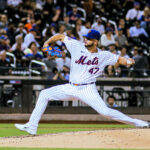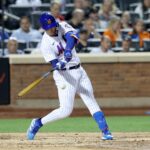
Stat Line: 6 IP, 2 R, 8 H, 3 BB, 1 HBP, 3 K
During last night’s 3-2 loss to the Milwaukee Brewers, New York Mets starting pitcher Jon Niese showed that he’s officially turned the page on his awful May performances (1-4 with 5.56 ERA, 4.55 FIP in May). During this article I will explain the positives and negatives to take away from Niese’s start against the Brewers.
Positives
Cut-Fastball aka Cutter
If you’re wondering, “How is Niese jamming Brewers hitters with an 87 mph pitch? How did Jean Segura miss what looked to be an 87 mph fastball right over the plate in his sixth inning at-bat?” It’s all in Niese’s cutter.
Much like a hard slider, a cutter can be the most unhittable pitch in the MLB due to its fastball tight spin coupled with its fastball like speed. This creates a pitch that breaks only two to four inches but in the last five feet to the hitter, which is when most MLB hitters begin their swing. The movement so quick, so small and so late in the pitch trajectory that the hitter doesn’t realize the movement until after they have completed their swing. The cutter will have just enough movement to stay away from the barrel of the bat, either jamming the opposing hitter or inducing a swing and miss.
Last night’s performance proves Niese’s cutter is the catalyst to his pitching success when comparing it his early season struggles when he relied too heavily on his four-seam fastball.
Kept Pitches Low
Via Brooks Baseball PitchF/X Tool, Niese threw only 22 of his 99 pitches belt high and above against Brewers hitters, with some of those thrown intentionally to induce strikeouts (See Aramis Ramirez and Adam Lind strikeouts in fifth inning). In case you missed it, there are three main advantages to keeping the baseball down in the strike zone as noted in a previous breakdown of Noah Syndergaard from May 28.
As I noted earlier in the season, keeping the baseball low in the zone is Niese’s only chance for success at the Major League level due to a lack of speed in his fastball which gives him no forgiveness when he misses up in the zone and a lack of a strikeout pitch which makes it tough for him to get out of jams.
Negatives
Lack of a Strikeout Pitch
Niese still struggles to strikeout hitters when ahead in the count due to a lack of a sharp breaking off-speed pitch and overpowering or deceptive fastball. Niese did a good job of striking out Ramirez and Lind on high fastballs but that was a more a product of setting up those hitters to chase that high fastball than it was his fastball overpowering or deceiving the hitter.
Additionally, Niese doesn’t vary pitch speeds well to help his fastball look harder than it really is which is also known as throwing a “deceptively” hard fastball. Via Brooks Baseball PitchF/X Tool, Niese only threw 11 of his 99 pitches below 85 mph, all of which were curveballs sitting around 75 mph.
A finesse pitcher like Niese should have at least 8 to 12 mph difference between his fastball and his two off-speed pitches. Since Niese throws his changeup only 5 mph slower than his fastball, he should work on his curveball which is 15 mph slower than his 90 mph fastball, much like Noah Syndergaard uses his 75 mph curveball against his 98 mph fastball. Another avenue for Niese would be to try different changeup grips to allow his changeup to drop down to 80 mph which will help induce more swing and misses.
Dropping his Elbow
It should be noted that in the fourth through sixth innings of his outing, Niese began to drop his elbow below his shoulder during his throwing motion on some of his fastballs and cutters. This usually occurs when a pitcher is trying to place or guide the baseball to a location rather than throw it to a location. This results in missing either way up or way down, too far away from the strike zone to induce any swings or called strikes.
Take Away
If Niese can continue to keep the ball down in the zone and command his cutter, he can compete as a back-end starter for the Mets. The best case scenario is that Niese continues this decent success, build’s trade value back up and the Mets are able to trade him before the trade deadline in July.
P.S. Although we have no idea on the timetable, I can’t wait to watch Steven Matz.
Follow Chris Zaccherio on Twitter @ziography for more Mets pitching insight that goes beyond statistics.















